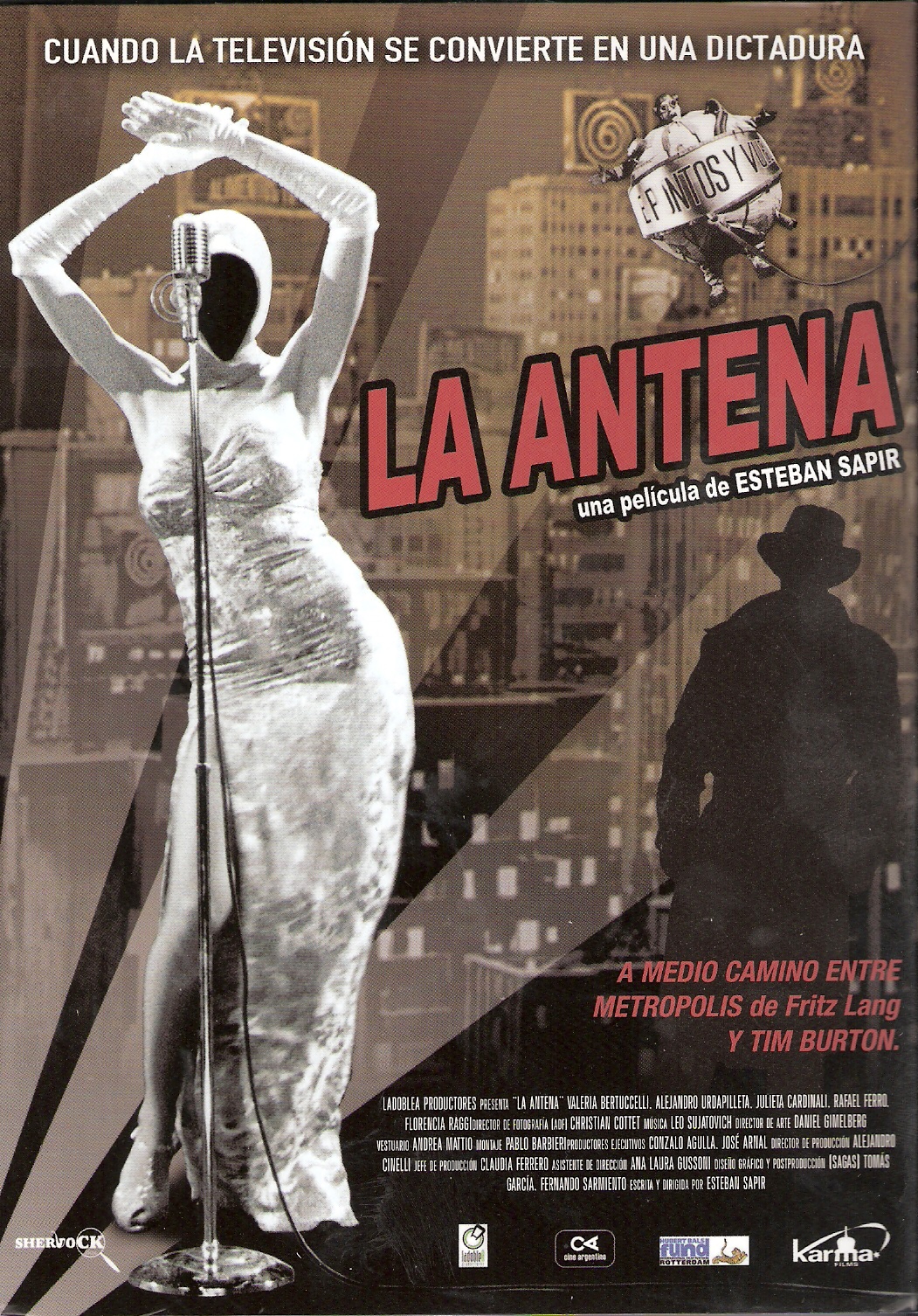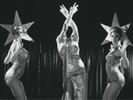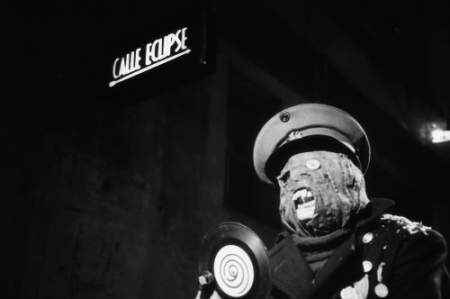
Predivno stiliziran polunijemi distopijski film o gradu koji je izgubio glas, a oteo ga je Mr. Televizija: Maddin, Jeunet i Méliès pomnoženi njemačkim ekspresionizmom i podijeljeni Orwelom. (Priča baš i nije bogznašto, vizualni aspekt je puno dojmljiviji.)
Cijeli film:

La Antena (English: The Aerial, 2007) is an Argentine drama film, written and directed by acclaimed film director Esteban Sapir. The film features Alejandro Urdapilleta, Rafael Ferro, Florencia Raggi, and others. It was released to cinemas in the United Kingdom on 16 May 2008 by Dogwoof Pictures, with a DVD-Video release following on 18 August 2008.
In the imaginary future, a heartless city is under a curse of the sly Mr. TV. He steals people’s voices and scrutinizes their lives. Meanwhile he is developing a machine to control the hearts of people, using television. In order to make this project successful, Mr. TV must kidnap the last person who still has a voice. Inspired by the German expressionist cinema, “The Aerial” is a remarkable experimental work that reminds the viewer of the pleasure of enjoying classic silent films. The photographer-turned-film director is interested in communication through images and effectively eliminates words from the film to make the viewer concentrate on images.
Uticaj medijske propagande na konstrukt
prosječnog čovjeka postaje sve manje očit u vremenu koje promoviše smrt
ideja. Medij, koji je u svom omjeru pristupačnosti i adaptiranosti
postao pragmatska prečica hijerarhije moći, je iluzorno uvjerljiva
televizija. Televizija kao neka vrsta multimedijalnog otpada različitog
dejstva, u istom trenutku postaje mjesto otkrića i mjesto davljeničke
potrebe za utapanjem u bezličnu masu paranoidne normalnosti. Sa prodorom
marketinški začinjene mediokratije prostor otkrića polako nestaje, te
mjesto ustupa hipnotičkom šarenilu površnosti koje postaje metoda
samosvjesne lobotomije pojedinca koji želi biti isti, jednak i
uklopljen, no i metoda novopronašle moći odašiljača koji su konstrukt
shvatili, te se otisnuli u primordijalno dejstvo egocentričnog ludila u
modusu svetosti moći kao smisla.
Posljednji dugometražno uradak Estebana
Sapira La Antena pokušava problematizirati temu
televizijsko-marketinškog kulta kroz narativni okvir Grada bez glasa, u
kojem pojam glasa ne bivstvuje niti u svom akustičnom, ali niti u
intelektualnom smislu. Prosječni žitelji normalnosti pronalaze smisao u
gledanju obožavanog i jedinog TV programa, koji pritom reklamira
preporučene proizvode, od kojih je najeksponiraniji desert imena TV
hrana, što je zapravo i jedina hrana u medijskom konc-logoru. Ličnost
koja je vlasnik televizijskog koncerna naziva sebe prigodnim imenom
Gospodin T.V.. Isti peron-berluskonijevski zamorac ujedno kontroliše i
sve ostale gradske segmente. Njegova stvarna moć je zapravo proizašla iz
krađe glasova, u svakom smislu, i njihovog prosljeđivanja
radničko-dječjem božanstvu koje ih zatim artikuliše kroz medijski
prostor stvarajući sliku orvelijanskog kvaliteta. Njegovu ugodnu
distopiju remeti sve veća glad božanstva, a jedini spas pjeva u gospođi
Glas, estradnoj bezličnoj marioneti kojoj božanstvo nije uspjelo još
uvijek uzeti glas. T.V. pokušava ubijediti gospođu Glas da pristane na
eksperimente Doktora Y, no ona zahtjeva televizijske naočale za svog
bezočnog sina. Transgenderski sin gospodina T.V.-a brojčanom slučajnošću
ne dostavi naočale na željenu adresu, što će rezultirati opiranju
gospođe Glas i njenom krajnjem ubistvu. Ubistvu će posvjedočiti
Izumitelj, otpušteni TV serviser, te će noarovski otkriti postojanje
drugog glasa kojem je namijenjena ista sudbina kao i njegovoj majci.
Daljnji razvoj zapleta će ga odvesti u pokušaj gerilskog svrgavanje
vođe, uz pomoć svog homoerotskog seksipila i disfunkcionalne porodice.
Smještanjem radnje u Metropolisom
obojenu snježno-pernatu distopiju, historijski blisku graničnom području
nijemog i zvučnog filma, Sapir je pružio sebi alate njemačkog
ekspresionizma kao vodeće. Stvarajući čudnu fuziju nijeme
ekspresionističke estetike, animiranih titlova koji postaju integralan
dio filmske fotografije i nadrealističkih uticaja, Sapir je uspio
proizvesti vizuelno intrigantan filmski jezik, koji svoje alegorijske
naslage polaže na vizuelnu simboliku, držeći svoj narativni okvir u
opticajima bajkovitog noara. Međutim, pomenuta simbolika često zna
potonuti u banalnosti pokušavajući se naivno ugurati u historijski
problem židovskog pitanja u Argentini. Ova problematika je mnogo bolje
funkcionisala u Sapirovom dugometražnom prvijencu Picado fino, unutar
mreže disocijativnog nadrealističkog ludila. To donekle narušava
poprilično dobro građenu borhesovsku kritiku totalitarizma prožetu
novozavjetnim metaforama, koju kroz izvrsnu filmsku fotografiju i
ritmičnu montažu, Sapir postavlja u matricu La Antene kao ostvarenja
prevashodno idejnog dejstva. Vodeći se tim postupkom glumačka postava
poprima marionetska obilježja, što većim tokom radnje dobro funkcioniše,
uz povremena skliznuća u pretjeranu teatralnost, da li zarad neuspjelog
humora ili jako riskantnog ekspresionističkog pristupa glumi. Još jedan
od mogućih problema La Antene tiče se pretjeranog forsiranja
postmodernističke kadrovske i dijaloške parafraznosti, koja izgleda
usiljeno i nadasve kao egocentrična rediteljska egzibicija često
promašenog konteksta, tek povremeno uspjevši rekontekstualizirati motiv.
Fabularna struktura se drži jednostavne postavke, ne trudeći se
opterećenjima novih zapleta i raspleta, što u kombinaciji vizuelne
simbolike kao dominante funkcioniše prilično dobro. Eventualne zamjerke
se mogu uputiti povremenim izletima u patetičnost unutar trenutaka
pomenutog problema sa teatralnošću. Sapirova pozadina u filmskoj
fotografiji jasna je vidljiva i u koncepcijskog zamisli filma kao
svrsishodne i cjelovite pokretne slike, što je slušljivo i u samoj
muzičkoj realizaciji Lea Sujatovicha, koja je vrlo duboko involvirana u
svojoj ekspresionističkoj poetici u samu filmsku strukturu, time
stvarajući dojam kompaktne cjeline.
La Antena uspijeva relativno bogate
simbolične fragmente sprovesti u fluidnu viziju. Centrirajući se na
tematiku fašistoidne mediokratije i njenih posljedica, Sapir u
distopijsku sliku integriše i tematiku katarzičnog otpora
totalitarizmu, no ne upada u zamku kao Lang u Metropolisu, koji je, iako
metaforično bogatiji od La Antene, završio u banalnom raspletu i
sretnom kraju. Kraj u kojem Sapir postavlja intrigantna pitanja o
nemogućnostima funkcionisanja mase i višeglasja, te mogućnostima
zaborava nepoznatih heroja, u konačnici La Antenu čine solidnim
ostvarenjem ambicioznog idejnog zahvata, unatoč nemalom broju problema,
koji svakako utiču da njena zamisao ne djeluje na metaemocionalnom nivou
kakav bi njen potencijal želio. - Amar Samilhodžić
Who needs the spoken word? The world would be a better place without it. Think of it: no more dunderheads droning their ill-informed opinions. No more over-excited teens screeching on the bus. And you’d never have to cram your fingers in your ears to block out James Blunt again. Heavenly.
Of course, there’s a downside, which is why the caption card declaring “Once upon a time there was a city without a voice…” introduces a dystopian world, one controlled by the evil Mr TV with the aid of hypnotic television broadcasts. Caption card? Oh, didn’t we say? This Argentinean film is a loving homage to the early days of cinema.
It proves that occasionally the best way to create something startlingly fresh is to turn to old, out-dated methods. Some of director Esteban Sapir’s homages are easily spotted: a moon with a human face straight out of Georges Méliès’s Le Voyage dans la Lune; a nod to the robot Maria from Metropolis. But you don’t have to be steeped in silent cinema to appreciate this anti-corporate allegory. By making use of a storytelling vocabulary – and an acting style – that’s almost a century old it refreshes jaded palettes, reminding you of the potency of the image.
Ingenious use of typography compensates for the lack of dialogue. The inhabitants of the unnamed city may have no voice but they can still speak, producing captions which they can interact with; a machine-gun fills the screen with “RA-TA-TA-TA-TA”s, and when the villain barks “Lock him up forever!” the words tumble down and enclose his victim.
Unfolding in the midst of a never-ending snowfall, it’s a hauntingly beautiful work: inventive, elegiac, gently surreal. If David Lynch had been around in the 1920s, it’s exactly the kind of film he would have made. - Ian Berriman
"Once upon a time there was a city without a voice. Somebody had taken away the voices of all its inhabitants. Many, many years went by and nobody seemed bothered by the silence."
In La Antena (The Aerial), Esteban Sapir realises his mute fairytale dystopia by using all the monochrome expressionist stylisations of silent-era cinema - not that the 'city without a voice' is ever completely quiet. For while we rarely hear a human voice, there is noise, there is music, and there is even, in moments of supposed silence, the clearly audible sound of the film reel itself whirring (as though this really were being shown on a clunky old projector from the 1920s).
 And of course, as the quote above suggests, there is text. "They have
taken our voices but we still have words," as one character puts it –
and so the citizens are still able to communicate by reading each
other's lips, signs, notes, mail, or even subtitles (which in this film
have a physicality that makes them available for characters as much as
for viewers to see).
And of course, as the quote above suggests, there is text. "They have
taken our voices but we still have words," as one character puts it –
and so the citizens are still able to communicate by reading each
other's lips, signs, notes, mail, or even subtitles (which in this film
have a physicality that makes them available for characters as much as
for viewers to see).Here a 'whispered' line can be half-covered with an overcoat to conceal it from prying eyes; one man blows a smoke ring to form the 'o' in his speech; another uses a 'megaphone' to make his subtitles appear larger; words can be angrily swept from the screen; the 'RAT TAT TAT' of a machine gun bursts all over the sky; and a shift to an over-the-shoulder reverse angle shot also reduces a character's subtitled dialogue to mirror writing (now that his words are being viewed from behind). All this wittily deconstructs the conventions of subtitles and intertitles – but it also celebrates the resilience and ingenuity with which humanity finds a way to communicate. Even in the absence of articulated utterances, the written word has taken on its own concrete solidity as a means of expression, allowing something like civilised life to go on in a populace that is otherwise muzzled.
A despotic industrialist named Mr TV, however, who mass-produces 'TV Foods' and who has monopolised the city's ubiquitous television station, is plotting to take away people's words too. To this end, he has abducted a hooded woman, known as 'the Voice' for her mysteriously retained ability to speak, and has strapped her to Dr Y's diabolical, swastika-shaped device, set to begin sending its mesmeric transmission at midnight. It seems that the only people who can stop Mr TV and restore the city's long lost voice are a down-at-heel television repairman, his broken family and the Voice's eyeless son Tomás (who has inherited her powers of speech), who must all race to the abandoned Aerial in the mountains before the city is silenced once and for all.
Reflexive, allegorical and poetic, La Antena is a dizzyingly dense piece of cinema, thriving on paradox, and always matching its medium to its message. Even as it shows a mute nightclub 'singer' who can only lip sync along to a stuck record, it also keeps offering overt quotations from past movies (e.g. Georges Méliès' A Trip to the Moon, Fritz Lang's Dr Mabuse, The Gambler and Metropolis, George Franju's Eyes Without A Face, Richard Fleischer's Soylent Green, Terry Gilliam's Brazil, David Lynch's Eraserhead and Mulholland Drive - the latter, in fact, referenced precisely by the lip syncing scene) - as though to suggest that filmmaking might itself be condemned always to sing the same old tunes.
It is an impression only enhanced by Sapir's decision to confine himself to the black-and-white stylings, quirky sets and outmoded histrionics of cinema's silent era – and yet the director's sheer inventiveness and exuberance enable him to soar above his self-imposed constraints. "Imagination has saved men" is the message passed down to the television repairman from his mother – and imagination is something that Sapir deploys time and time again, saving us from the sort of bland homogeneity or slavish imitation that marks so many other, inferior films.
Sometimes cinema tickles the senses, sometimes it tugs at the heartstrings, sometimes it exercises the intellect – but La Antena transmits to all three at once. For Sapir's film is visually beautiful, mentally stimulating, and thoroughly haunting. Sophisticated to the last, it may allegorise the tyranny of consumerism and the deadening effects of the mass media, but in the end even freedom itself is made to equivocate between miracle and horror, leaving viewers to decide for themselves whether the film's final sounds are the ecstatic cries of a newborn, or a more harrowing expression of Munchian angst.
Either way, it would be dumb not to tune in to this extraordinary film. - Anton Bitel
Both less inventive and less substantial than it seems to think it is, Esteban
Sapir’s Argentinean, sci-fi, would-be epic
The Aerial actually suffers from the
comparisons it prompts as it tries to reference a series of silent classics.
Featuring a retro conception of the future that seems borrowed from better films
like Brazil or
Sky Captain and the World of Tomorrow,
the movie is not set in the silent era, despite the fact that it’s a silent
film. In fact, the plot actually centers on a nefarious scheme involving
television broadcasting used to brainwash and silence the masses. The story,
which never gains any urgency despite rampant cross-cutting, verges on kitsch,
and almost seems more suited for an animated film than a live action feature, no
matter how stylized an exercise this might be. The wildly exaggerated
performances never click, and always feel a bit amateurish. The political
undercurrents are facile, never evolving beyond the surface level. Ultimately,
there’s not much here beyond empty technique and shallow allusion (several black
and white classics, such as George Melies’
Voyage to the Moon and
Citizen Kane are given explicit
visual nods).
There have been several wholly successful silent movies made in homage over the
last few years. Rolf de Heer’s Dr. Plonk,
Andrew Leman’s The Call of Cthulhu,
and the work of Guy Maddin all come to mind. Unlike most of these movies,
though, The Aerial uses a
considerable amount of digital trickery to spice up its images. Although this
allows the filmmakers to invent some neat effects, such as the imposition of the
words that the characters speak as actual physical objects in their world, there
seems something a tad undisciplined about using newfangled technology (or the
widescreen frame, for that matter) in this kind of deliberate throwback. There’s
little rigor in Sapir’s scattershot approach, cheapening the viewing experience
considerably. Admittedly, some moments of imagination make their way to the
screen, as do some noteworthy cinematographic flourishes. For example, one
supporting character is a creepy looking boy without eyes and his mother gets a
lively musical sequence or two, but those seem small rewards for viewers, given
the potential of this sort of thing. One must also concede that at times Sapir
manages to convey an impressive sense of scale, especially if one considers the
relatively low-budget roots of the film. At the same time, considering those
financial roots of the project seems to be making excuses for what is a
fundamentally overambitious and underdeveloped work.- www.moviemartyr.com/


Nema komentara:
Objavi komentar